Far Eastern Himalayan Landscape
Type of resources
Topics
Keywords
Contact for the resource
Provided by
Representation types
Update frequencies
status
Scale
-
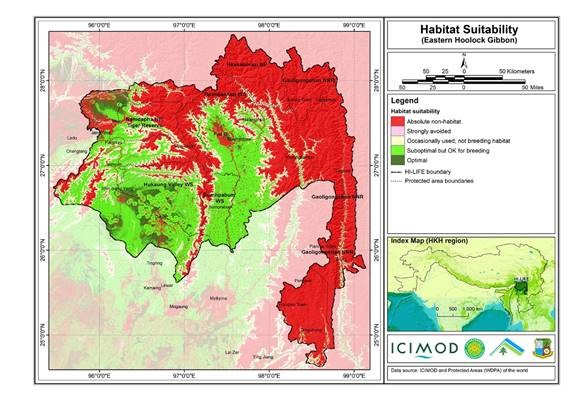
The Hindu Kush Himalayan region (HKH) is an important biodiversity hotspot with more than 488 protected areas covering 39% of the region's geographical coverage. A majority of the protected areas are small and isolated and are not large enough to address conservation challenges. Only about 20% of the protected areas are transboundary in nature. There is limited data available on habitat suitability for conservation planning and landscape management in the Far Eastern Himalayan Landscape. A study carried out under the Landscape Initiative for Far Eastern Himalayas (HI-LIFE) Initiative at ICIMOD, estimates habitat suitability for the Eastern hoolock gibbon in the Far Eastern Himalayas using remote sensing and geographic information system tools, and available secondary information.
-
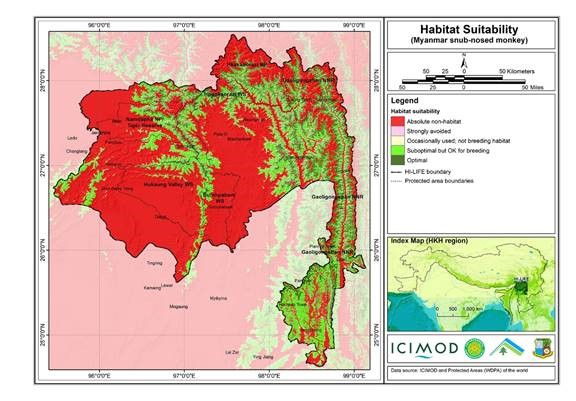
The Hindu Kush Himalayan region (HKH) is an important biodiversity hotspot with more than 488 protected areas covering 39% of the region's geographical coverage. A majority of the protected areas are small and isolated and are not large enough to address conservation challenges. Only about 20% of the protected areas are transboundary in nature. There is limited data available on habitat suitability for conservation planning and landscape management in the Far Eastern Himalayan Landscape. A study carried out under the Landscape Initiative for Far Eastern Himalayas (HI-LIFE) Initiative at ICIMOD, estimates habitat suitability for the Myanmar snubnosed monkey in the Far Eastern Himalayas using remote sensing and geographic information system tools, and available secondary information.
-
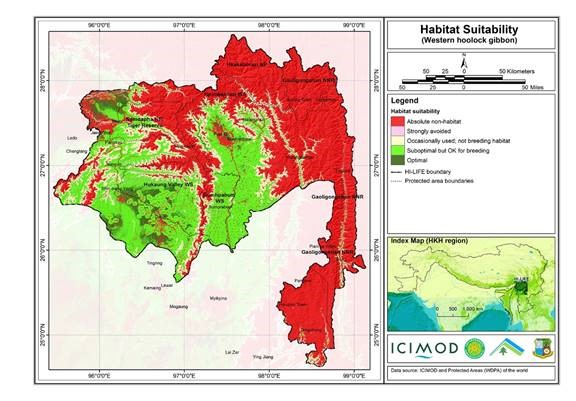
The Hindu Kush Himalayan region (HKH) is an important biodiversity hotspot with more than 488 protected areas covering 39% of the region's geographical coverage. A majority of the protected areas are small and isolated and are not large enough to address conservation challenges. Only about 20% of the protected areas are transboundary in nature. There is limited data available on habitat suitability for conservation planning and landscape management in the Far Eastern Himalayan Landscape. A study carried out under the Landscape Initiative for Far Eastern Himalayas (HI-LIFE) Initiative at ICIMOD, estimates habitat suitability for the Western hoolock gibbon in the Far Eastern Himalayas using remote sensing and geographic information system tools, and available secondary information.
-
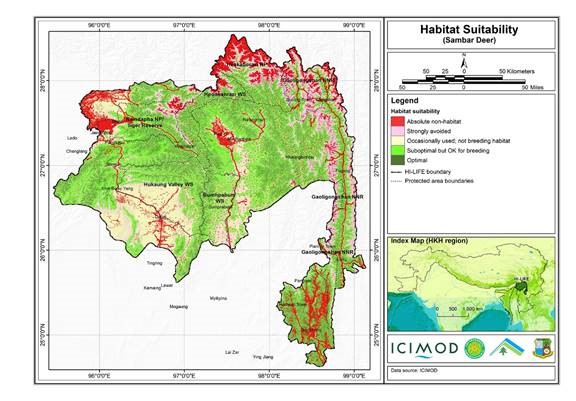
The Hindu Kush Himalayan region (HKH) is an important biodiversity hotspot with more than 488 protected areas covering 39% of the region's geographical coverage. A majority of the protected areas are small and isolated and are not large enough to address conservation challenges. Only about 20% of the protected areas are transboundary in nature. There is limited data available on habitat suitability for conservation planning and landscape management in the Far Eastern Himalayan Landscape. A study carried out under the Landscape Initiative for Far Eastern Himalayas (HI-LIFE) Initiative at ICIMOD, estimates habitat suitability for the Sambar deer in the Far Eastern Himalayas using remote sensing and geographic information system tools, and available secondary information.
-
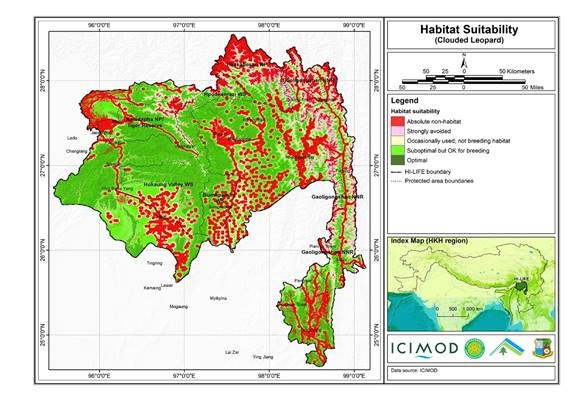
The Hindu Kush Himalayan region (HKH) is an important biodiversity hotspot with more than 488 protected areas covering 39% of the region's geographical coverage. A majority of the protected areas are small and isolated and are not large enough to address conservation challenges. Only about 20% of the protected areas are transboundary in nature. There is limited data available on habitat suitability for conservation planning and landscape management in the Far Eastern Himalayan Landscape. A study carried out under the Landscape Initiative for Far Eastern Himalayas (HI-LIFE) Initiative at ICIMOD, estimates habitat suitability for the Clouded Leopard in the Far Eastern Himalayas using remote sensing and geographic information system tools, and available secondary information.
-
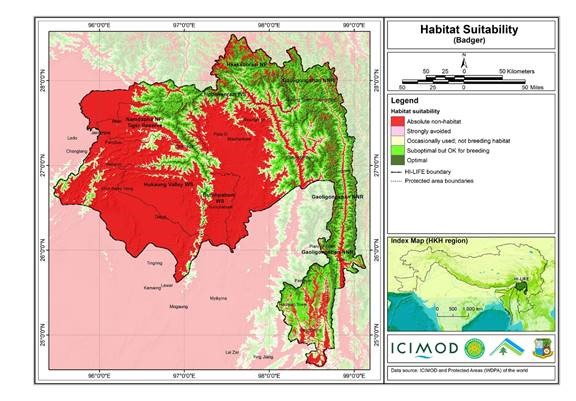
The Hindu Kush Himalayan region (HKH) is an important biodiversity hotspot with more than 488 protected areas covering 39% of the region's geographical coverage. A majority of the protected areas are small and isolated and are not large enough to address conservation challenges. Only about 20% of the protected areas are transboundary in nature. There is limited data available on habitat suitability for conservation planning and landscape management in the Far Eastern Himalayan Landscape. A study carried out under the Landscape Initiative for Far Eastern Himalayas (HI-LIFE) Initiative at ICIMOD, estimates habitat suitability for the Badger in the Far Eastern Himalayas using remote sensing and geographic information system tools, and available secondary information.
-

The Hindu Kush Himalayan region (HKH) is an important biodiversity hotspot with more than 488 protected areas covering 39% of the region's geographical coverage. A majority of the protected areas are small and isolated and are not large enough to address conservation challenges. Only about 20% of the protected areas are transboundary in nature. There is limited data available on habitat suitability for conservation planning and landscape management in the Far Eastern Himalayan Landscape. A study carried out under the Landscape Initiative for Far Eastern Himalayas (HI-LIFE) Initiative at ICIMOD, estimates habitat suitability for the takin in the Far Eastern Himalayas using remote sensing and geographic information system tools, and available secondary information.
-

The Hindu Kush Himalayan region (HKH) is an important biodiversity hotspot with more than 488 protected areas covering 39% of the region's geographical coverage. A majority of the protected areas are small and isolated and are not large enough to address conservation challenges. Only about 20% of the protected areas are transboundary in nature. There is limited data available on habitat suitability for conservation planning and landscape management in the Far Eastern Himalayan Landscape. A study carried out under the Landscape Initiative for Far Eastern Himalayas (HI-LIFE) Initiative at ICIMOD, estimates habitat suitability for the Himalayan black bear in the Far Eastern Himalayas using remote sensing and geographic information system tools, and available secondary information.
-
This checklist of bird diversity in the Far Eastern Himalayan Landscape (which covers parts of China, India, and Myanmar) contains a total of 908 species extracted from the literature on the landscape, including several peer-reviewed journals, books/chapters, and published reports.
-
This is a checklist of flowering plant diversity in the Far eastern Himalayan Landscape comprising parts of China, India and Myanmar. It contains a total of 5283 species collated from published resources such as peer-reviewed journals, books and reports reviewed during a systematic review of plants from the Landscape.
 Metadata Catalogue
Metadata Catalogue